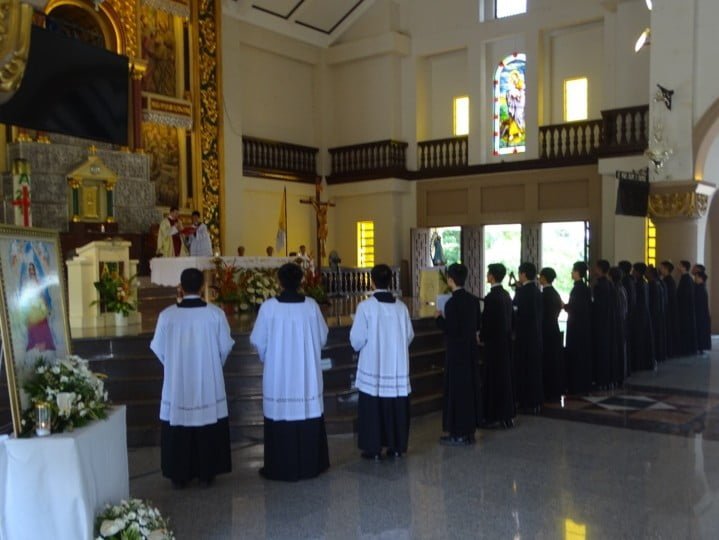
The newly professed brothers with some of the concelebrating priests
“The Miracle of the Transfiguration, by which Christ showed His disciples the glory and beauty of His Body encourages us to tolerate difficulties by that brief contemplation of eternal joy … It also reminds us of the specific end of our small Religious Family: to evangelize culture – to transfigure it into Christ. Therefore, on every August 6th, the Feast of the Transfiguration of the Lord, we will always commemorate what constitutes our Religious Family, and what must distinguish it from among the Church’s various religious families.” This excerpt from our Constitution explains the reason of the significance of the Transfiguration of the Lord for us.
Through that brief vision of the glory of the Transfigured Christ, the pillars of the future Apostolic Church, Peter, James and John, were able to be sustained through the dark night of the passion and death of Jesus when the promise and hope which had manifested itself so brightly turned into a dark night of seeming hopelessness.
The specific end of our small Religious Family of the Incarnate Word is the evangelization of culture. For this reason, the Feast of the Transfiguration, where Our Lord manifested his glory to the Peter, James and John, is a special Feast for us wherein we celebrate our charism of inserting the Gospel into the various cultures.
The Transfiguration shows us how the Divinity of Christ assumed His Humanity in the Person of Jesus and in doing so, assumed all that is authentically human. This teaches us the 3 important elements of the evangelization of culture. First, to remove that which is contrary to the Gospel, for example, polygamy, blood sacrifice and the like in many pre-Christian cultures. Secondly, to assume what is authentically human in those cultures and finally and most importantly, to insert the Gospel into those cultures. The evangelization of Europe leading to the formation of what was Christendom and the Spanish Christianization of the Americas provide good examples of how this insertion was successfully and harmoniously done.
In the House of Formation, the week surrounding August 6th, the Feast of the Transfiguration is filled with various activities celebrating the various aspects of culture.
Culture Week began with a Melodium where the Requiem of Mozart was presented by Fr. Federico Jaramillo, IVE, the Master of Novices and Br. Victor Galvez. They traced the life of Mozart, whose music was once described by Joseph Cardinal Ratzinger, later Pope Benedict XVI, himself called the “Mozart of theology” by Joachim Cardinal Meisner of Cologne for the directness, clarity and form of his theological expression, as “… so luminous and yet at the same time so deep. His music is by no means just entertainment; it contains the whole tragedy of human existence.”
The different elements of the composition of the Requiem, which Mozart started to compose on his deathbed and never finished, were presented and explained.
On Wednesday, Fr. Diego Ibarra, IVE, Rector of the Our Lady of Sheshan Major House of Formation, gave a presentation of Matteo Ricci, SJ and his book, “The Real Meaning of the Lord of Heaven”. This book is the fruit of Ricci’s long study and dialogue with the Confucian scholars of China in the 16th century. Fr. Diego presented the elements of Ricci’s study, presented in the form of a dialogue between a Catholic and a Confucian scholar, in several steps: The Removal of the elements of Buddhist accretions to the authentic Confucian teachings, the Restoration of Primitive Confucianism and finally the Completion and Fulfillment of Confucianism that is found in Christianity. Fr. Diego highlighted in particular the use of Thomistic philosophy in the exposition of Ricci to discuss God as Creator and Ruler of the Universe, the subsistence of the human soul, etc and also in his refutation of the Buddhist errors in those regards, especially in respect to monism and the distinction between God and the world.
We then had a Convivium in which various brothers presented their own artistic works such as drawings, Chinese paper cuttings, poetry and music.
On Saturday, Polyglosis, in which different literary works were presented in various languages as language is the primary means through which culture is transmitted. This year, works were presented in 11 different languages, including Latin, Telugu, Tamil, Malay, Mandarin, Cantonese, Spanish, Russian, Tagalog, Cebuano, etc.
On Sunday, August 6th, the Feast of the Transfiguration of the Lord, the Religious Family of the Incarnate Word gathered at the parish of Mary Mediatrix in Lipa to celebrate the First Profession of Vows of 9 new brothers and the renewal of temporal vows of 21 brothers. On this joyous occasion, the priests and seminarians and novices of the IVE were joined by the sisters of the SSVM and friends and family.
- The renewal of vows
- Filipino group
- Malaysian group
In his homily, Fr. Diego Ibarra, IVE, Rector of the Our Lady of Sheshan Major House of Formation reiterated the importance of the Transfiguration in the charism and life of our Religious Family and presented again the urgent and pressing need of the Evangelization of Culture against an aggressive and active ‘globalization’ and destruction of genuine culture now occurring in the world.
During the Mass, 9 seminarians professed the religious vows of poverty, chastity and obedience for the first time, and 21 others renewed their temporal vows.
A simple reception was held after the Mass in the Church hall. During the various festive presentations, the Fathers of the IVE and the sisters of the SSVM and the brothers of the IVE presented different pieces of music in Spanish, Mandarin, Tamil, Tagalog, Malay etc.
A simple reception was held in the hall below the Church after the Mass, to celebrate the event with our families, friends and benefactors.
The festivities ended with an anthem to Our Lady, sung in the different languages and the final blessing.















Leave A Comment